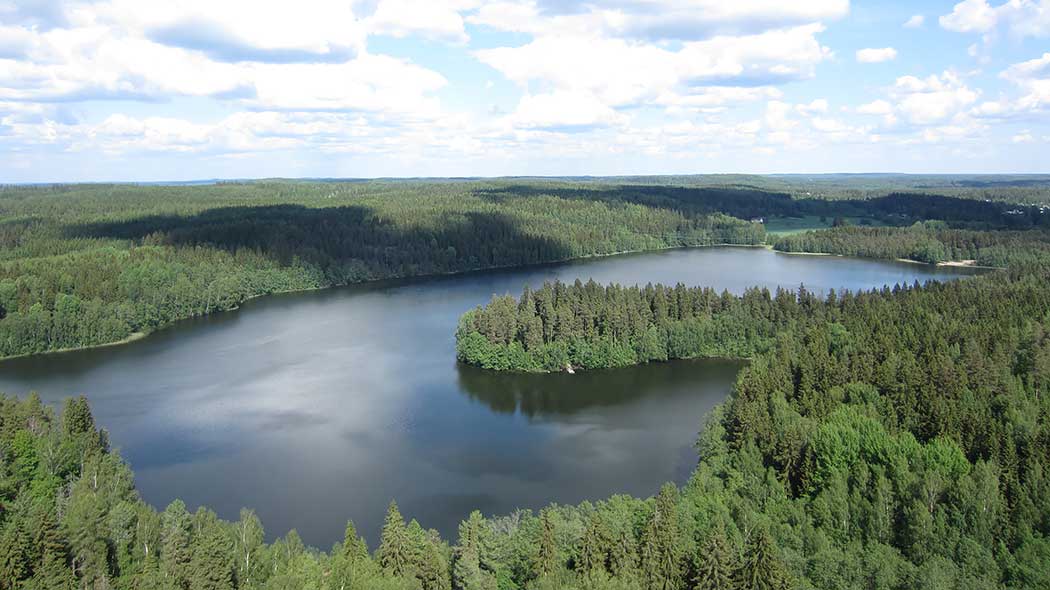Sights in Aulanko Nature Reserve

The View from the Tower over the National Landscape
 Already in the end of 1800s, Aulangonvuori Hill was a popular destination with groups for picnic trips. A small wooden pavilion was built on top of the hill to serve as a scenic lookout place. Nowadays, Aulangonvuori Hill is dominated by a 33-metres-tall granite tower built during 1906 - 07. This landmark-like tower resembles a castle tower, and it is designed by architect Waldemar Aspelin.
Already in the end of 1800s, Aulangonvuori Hill was a popular destination with groups for picnic trips. A small wooden pavilion was built on top of the hill to serve as a scenic lookout place. Nowadays, Aulangonvuori Hill is dominated by a 33-metres-tall granite tower built during 1906 - 07. This landmark-like tower resembles a castle tower, and it is designed by architect Waldemar Aspelin.
One of the Finnish national landscapes, the valley of Lake Vanajavesi, can be seen from the scenic lookout tower of Aulangonvuori Hill. The tower is open from 8 am to 8 pm daily during the summer (from Mother's Day till end of October). Admission is free.
Read more about the national landscape of the valley of Lake Vanajavesi.
The Art of Lennart Segerstråle
On the foot of the tower, there is a scenic lookout platform with a view towards Lake Aulangonjärvi. It was built in 1934. Below the lookout platform, there is a fresco about bear hunting painted by artist Lennart Segerstråle in 1934. Segerstråle has also made the signboards of the park, which are from the 1930s.
In the beginning of the 1900s, people were delighted by the fact that anyone could visit the forest park freely. Especially it was considered very progressive that there were signs at the forks of the trails pointing towards the most important sights. There are still the old pictures of the scenic lookout tower, a swan, the granite castle, and the Bear cave on the signboards painted by Segerstråle, telling you which way to go.
Bears and Swans - Pavilions and Ruins
 Next to the scenic lookout platform, there are stairs going down to the Bear cave, where you find a sculpture illustrating a bear family, made by sculptor Robert Stigell in 1905. On the foot of the scenic lookout tower is located the former residence of the forest warden, where coffee was sold to visitors already in the beginning of the 1900s. The building has been extended in the 1930s, and it still serves as a summer café.
Next to the scenic lookout platform, there are stairs going down to the Bear cave, where you find a sculpture illustrating a bear family, made by sculptor Robert Stigell in 1905. On the foot of the scenic lookout tower is located the former residence of the forest warden, where coffee was sold to visitors already in the beginning of the 1900s. The building has been extended in the 1930s, and it still serves as a summer café.
Lakes Joutsenlampi and Metsälampi (in Finnish "Swan Lake" and "Forest Lake"), located in the middle of the protected area, are artificial ponds made at the turn of the 19th and the 20th century. A footpath goes round Lake Joutsenlampi, with different species of trees and shrubs along the way.
The neo-Gothic style Ruusulaakso pavilion, located on the shore of Lake Metsälampi, is one of the two original pavilions from colonel Standertskjöld's time. It is decorated with many wooden ornaments, and it was probably built in the 1890s. The other one, Onnentemppeli pavilion, is made of tiles and it is located on a high stone mound along the ring road. Along Aulangontie road, there are the ruins of the granite castle, built by colonel Standertskjöld, which since 1961 have served as a summer theatre for children and youth.
In the southern part of the Nature Reserve, there was a gunpowder magazine of Hämeenlinna garrison. Remains of the square stonewall can still be seen. The magazine was built in the 1860s to be a part of Hämeenlinna garrison. However, the explosive gunpowder magazines had to be built far out of town for safety reasons. Nowadays, the area of the gunpowder magazine with its stonewall is a protected monument of antiquity. Inside the wall, a natural meadow is maintained.
